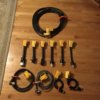Noo
Noooo! Danger Will Robinson!
Ground to ground, yes, but wire each of the lines from each the hots on the NEMA L6-20 to each of the terminals on the NEMA 5-20, i.e. L1 to the line side and L2 to the Neutral side.
That makes more sense. Whew, this is why I post these things to get input before I start hacking anything up. So you are replacing the neutral in this case with one of the 120v hots and the other one is as it would be normally. The UMC sees both of these as a hot supply line and just goes to 240v even though they're not coming in on a single terminal like a 5-20 normally would be.
Yeah, that fact that the car will just detect and use whatever voltage has made these kinds of adapter situations much easier.
Awesome. Great to know.
No, that is not how you wire it. You sure don't combine two of anything. You need to put the two wires that have voltage potential from one outlet type onto the two wires that have voltage potential of the other outlet type. Does that make more sense of what the goal is?
So the L6-20 has Hot1 and Hot2, which has a 240V difference. You connect those two wires onto the Hot1 and Neutral pins of the 5-20 side, because those are the wires where it is trying to see a voltage difference. Ground is always just Ground and should never be part of any of the two pins where you're trying to hook up the voltage for charging.
Good, that just felt... off typing it. lol
Yeah, explained that way & the previous post before yours I just quoted it makes more sense. I just need to go ground to ground, Hot wire 1 to one of the pins on the 5-20 and then the other hot wire 2 from the L6-30 to the other hot pin on the 5-20. Even though one of those pins is normally a neutral the UMC will see both 120v hots and allow 240v at 20A which it will set to 16A automatically.
Does that all sound accurate?



